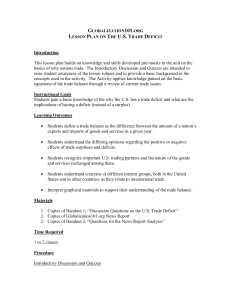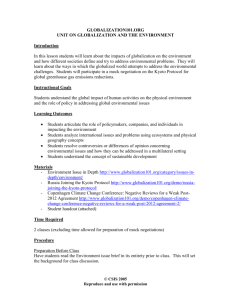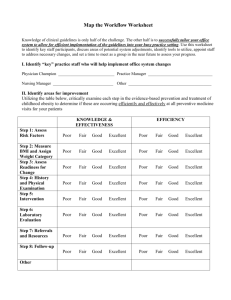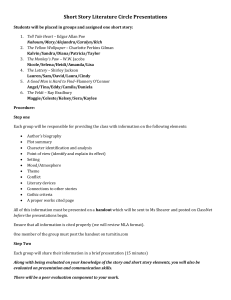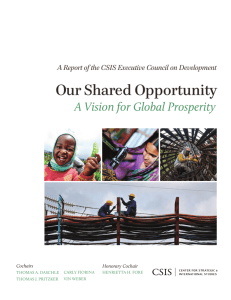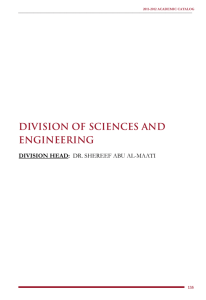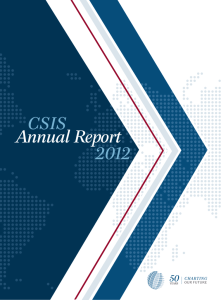Unit on Globalization and Foreign Investment
advertisement
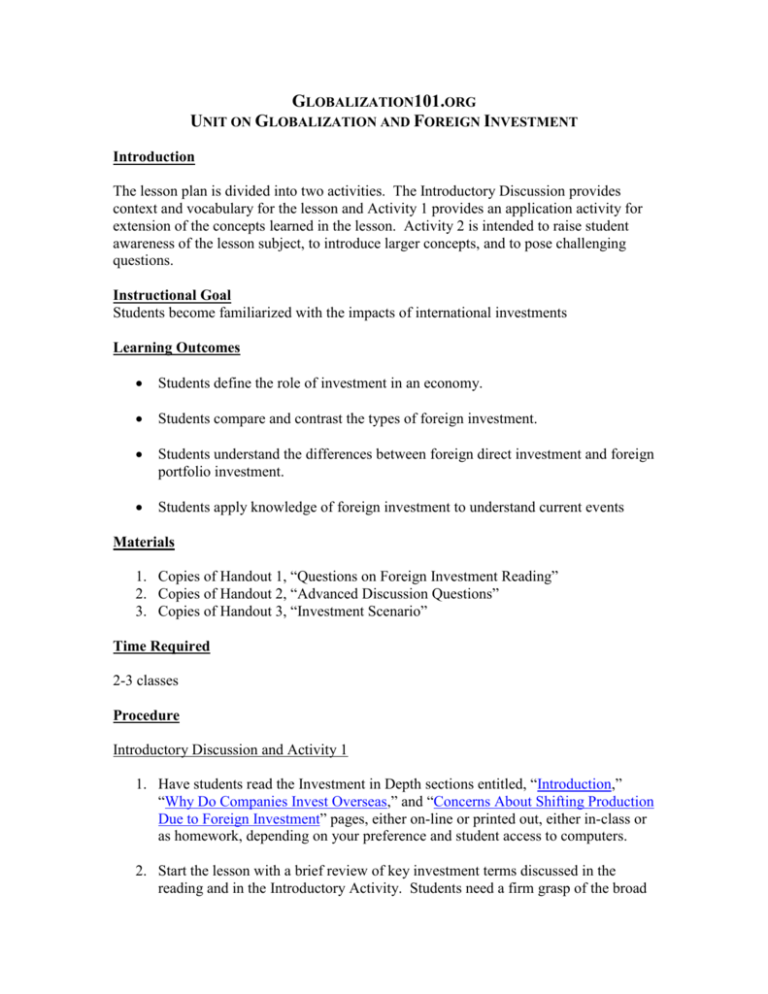
GLOBALIZATION101.ORG UNIT ON GLOBALIZATION AND FOREIGN INVESTMENT Introduction The lesson plan is divided into two activities. The Introductory Discussion provides context and vocabulary for the lesson and Activity 1 provides an application activity for extension of the concepts learned in the lesson. Activity 2 is intended to raise student awareness of the lesson subject, to introduce larger concepts, and to pose challenging questions. Instructional Goal Students become familiarized with the impacts of international investments Learning Outcomes Students define the role of investment in an economy. Students compare and contrast the types of foreign investment. Students understand the differences between foreign direct investment and foreign portfolio investment. Students apply knowledge of foreign investment to understand current events Materials 1. Copies of Handout 1, “Questions on Foreign Investment Reading” 2. Copies of Handout 2, “Advanced Discussion Questions” 3. Copies of Handout 3, “Investment Scenario” Time Required 2-3 classes Procedure Introductory Discussion and Activity 1 1. Have students read the Investment in Depth sections entitled, “Introduction,” “Why Do Companies Invest Overseas,” and “Concerns About Shifting Production Due to Foreign Investment” pages, either on-line or printed out, either in-class or as homework, depending on your preference and student access to computers. 2. Start the lesson with a brief review of key investment terms discussed in the reading and in the Introductory Activity. Students need a firm grasp of the broad 2 concepts of investment prior to learning more specific nuances. Prior to moving forward, be sure that students understand the basic dynamics of foreign investment, that companies choose to invest in other countries for a variety of economic reasons, and that a closer review of an often-articulated argument against foreign investment provides a balanced perspective. Glossary of Terms: http://www.globalization101.org/glossary-of-terms-2/ Import Substitution Industrialization: An international economic and trade policy based on the belief that a nation should reduce its dependency on foreign investment and goods by domestic production of industrial goods Interest rates: Interest rates have a powerful effect on the volume of a nation's money supply. By raising interest rates, i.e., making the cost of borrowing money more expensive, governments or banks can decrease the money supply. A decrease in the money supply tends to be counter-inflationary, which makes a currency more valuable compared to other currencies. 3. Distribute Handout 1 with discussion questions on the nature of foreign investment. The questions are divided into three subsets, corresponding to different portions of the Investment Issue in Depth: “What Are the Different Kinds of Foreign Investment?”; “Differences Between Portfolio and Direct Investment”; and, “Why Has Foreign Investment Increased So Dramatically in Recent Decades?” 4. Students will answer the questions in a “jigsaw” exercise. Divide students into groups of threes, and assign each student to respond to one subset of questions. Each student will then share his or her answers with the other students in the group. Each group should then present its answers to the class. 5. You may conclude with one of two options. First, you may summarize the discussion, drawing student attention back to the student objectives, checking for knowledge, and then providing a concluding assessment activity (if necessary). 6. Alternatively, you may assign the students the questions from Handout 2 to respond to as homework or as an in-class writing assignment. (The first two questions are also provided on the website) Activity 2: Role-Playing Exercise 1. This activity will present a brief scenario concerning a nation newly open to investment. A variety of investment choices will be available, and students will discuss the choices. Then, the facts of the scenario will change, and students will review their choices based on the changed circumstances. © CSIS 2005 Reproduce and Use with Permission 3 2. The scenario, described in Handout 3, is that of a small country whose Finance Minister is trying to attract new foreign investment and has three options for how to do so. 3. Read the scenario in Handout 3 to the class or provide a copy of Handout 3 to each student. Acting as the Finance Minister, ask students to evaluate the three different options for how to attract foreign investment. Students may answer orally in-class as a group, or individually as a written in-class or homework assignment. 4. Depending on your preference, you may assign students to do extra research using the Globalization101.org website, such as using the links in the Investment Issue in Depth to find out more information about foreign investment from governments, international organizations, or media websites. 5. After the students have tackled the initial round of questions, you can modify the scenario and have students respond to a new set of circumstances, such as the following: In the course of the deliberations, a series of violent incidents are initiated by a new, previously unknown revolutionary group. The group seeks to subvert the new government and seize private assets for redistribution to the poor. (Comment: threats to private property tend to frighten investors, and general unrest may lead to widespread civil disorder—a bad climate for development, discouraging large commitments by banks and other investors. Governments may see loans as a way of pacifying the revolutionaries.) A report by a human rights organization claims that in the new government’s zeal for domestic peace, large numbers of intellectuals and dissenters are being arrested and held without trials. (Comment: governments and international organizations often are concerned with public opinion in their home countries, and may seek to connect more freedom with more loans, or may wait until the political climate is more favorable. This usually has little effect on private investors.) The Finance Minister informs his staff that a group of commercial banks has indicated that they will provide substantial loans to the country, if they can receive commitments from the government that the money will be used for a series of infrastructure projects. These projects, however, are very unpopular with some citizens, and include a new oil pipeline and the damming of a rural river. (Comment: popular discontent towards foreign banks and the perception that these banks are seeking to tell the country what to do may lead to unwillingness on the part of the government to seek these loans. Conversely, the government may have intended the money for these uses anyway. International investors may be reluctant to © CSIS 2005 Reproduce and Use with Permission 4 get involved when local politics (in the Finance Minister’s country) are at issue. 6. End the scenario by asking students to think of the last two decades in world history. What events have occurred that have created situations like the one in the scenario (most classes will probably already have made that connection in the discussion, but the end of the Cold War is the most likely example)?. What countries still are either closed to foreign investment or only just starting down that path (for example, Cuba)?. How would the students describe a country like China in this context—open to investment, yet still controlled by a strong government that imposes many limits? Ask the students how knowledge of foreign investment helps them to understand today’s global financial crisis. © CSIS 2005 Reproduce and Use with Permission 5 Conclusion 1. Wrap up the unit by identifying the student objectives for the lesson and ensuring that the students have met them. 2. The themes and concepts of international investment will challenge even the most advanced high school students. Many will not be familiar with the nature of investment beyond a cursory knowledge of the stock market (not a perfect example, of course), and will have little to connect with to extend that knowledge to the global sphere. One suggestion is to draw a strong correlation between domestic and international investment: as in trade, much of the difference is in the scale and the nature of the participants. © CSIS 2005 Reproduce and Use with Permission 6 Globalization101.org Unit on Globalization and Foreign Investment Handout 1 Questions on Investment Reading 1. What Are the Different Kinds of Foreign Investment? Who makes the decisions for each of the four types of foreign investment? Why might foreign direct investment and foreign portfolio investment be grouped together in a single category? How does a commercial loan to a foreign business or government differ from that for a US business? What are some examples of “official flows” that you are familiar with? What are the different types of investment return that the investor might expect in each of the different types of investment? 2. Differences Between Portfolio and Direct Investment How do portfolio and direct investment differ? Why might a country prefer to encourage one form of investment over another? In Saudi Arabia, U.S. firms are not allowed to hold majority interest in oil production activities. Why do you think the Saudi government has created this restriction? How might the threat of a recession in a foreign country affect portfolio investment in that country? Can you think of some examples of foreign direct investment in the United States? Which industries seem to have the highest levels of FDI in the United States? Why do you think that is so? 3. Why Has Foreign Investment Increased So Dramatically in Recent Decades? How do the four factors affecting the increase in foreign investment differ? What do the factors have in common? How will these factors change in the next decade? In the next 20 years? What impacts might these changes have on the continued growth of foreign investment? What role did the U.S. government play in each of these factors? Was this role a conscious attempt to increase foreign investment? © CSIS 2005 Reproduce and Use with Permission 7 Globalization101.org Unit on Globalization and Foreign Investment Handout 2 Advanced Foreign Investment Questions 1. How do you evaluate the benefits or drawbacks of foreign investment? How much weight do you give to the concern that foreign portfolio investment (FPI) can lead to economic upheaval? Do you find the argument that foreign investment amounts to “buying” another country? What controls could be put in place to counter this concern? 2. What relationship do you see between Foreign Direct Investment and employment? Looking at the United States as an example—have you noticed a shift in the distribution of jobs over the past decade? What jobs are leaving the United States? Where are these jobs going? What jobs are replacing them? 3. What does the increase in international investment over the last two decades and the change in the nature of that investment say about broader historical changes in technology and communication and politics? © CSIS 2005 Reproduce and Use with Permission 8 Globalization101.org Unit on Globalization and Foreign Investment Handout 3 Investment Scenario The leadership of a small, but resource-rich, nation in North America recently changed. The new leaders have declared their intention to improve their aging industrial infrastructure, generate new jobs, and increase trade with the United States and Canada. In order to do this, the leaders have changed decades-old policies that kept all foreign investment out, and have stated they are open to any form of investment to help them as they pursue their new goals. The Finance Minister of the nation meets with his economists and examines the question of how to bring the most money into his nation. His staff ponders the question and tell him that he has three options: 1) 2) 3) Get banks overseas to loan money to help companies in the country. Ask the U.S. or Canadian government to give his country the money in the form of gifts or grants to build infrastructure Try to convince businesses in the U.S. or Canada to use their own money to fix up or buy factories in the country. The Finance Minister mulls over these options. They all have strong points and weak points. He then asks his staff the following questions: 1. What are the benefits of each option?—consider factors as diverse as how quickly the country could get the investment money, how people in the country might feel about the approach taken, and which promises the most money. 2. What are the drawbacks of each option?—consider the same factors. 3. What are some effects, both good and bad, of each option in areas that are not as obvious, such as the environment, cultural globalization, standard of living? © CSIS 2005 Reproduce and Use with Permission


